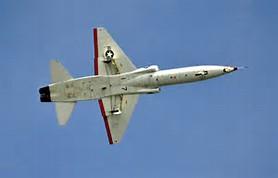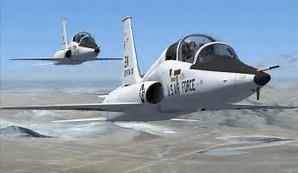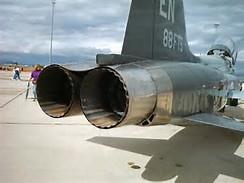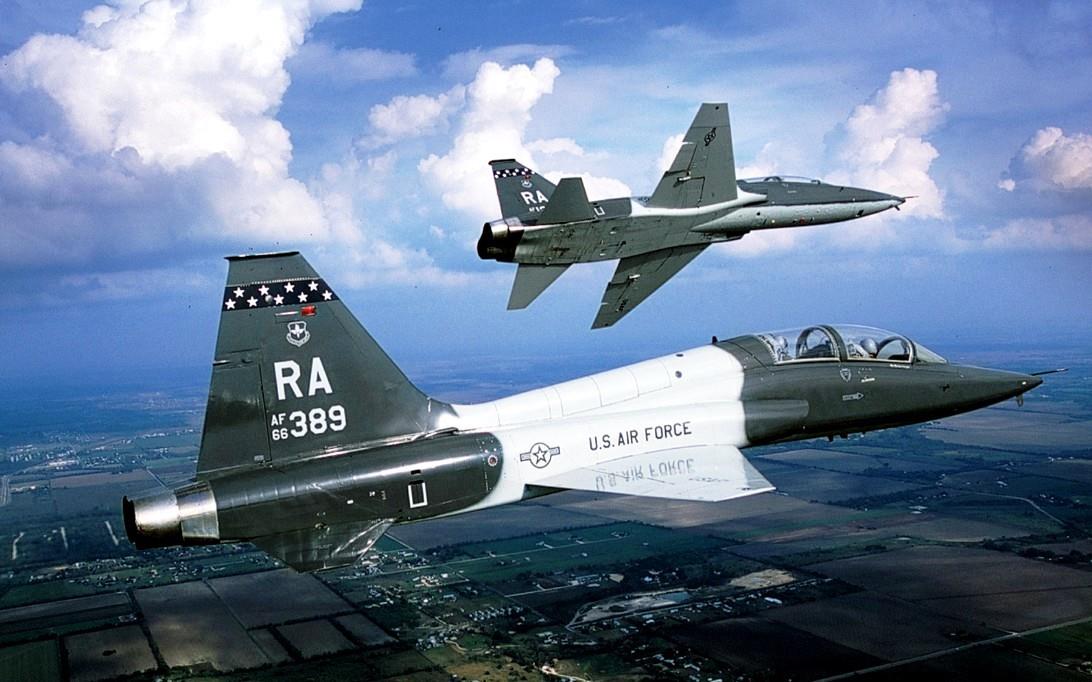S'sonic
Stealth
Menu
A free template by Lucknowwebs.com for WYSIWYG WebBuilder 8
Powered by Sispro1-S
Nigel G Wilcox
Paragon Of Space Publication
© Copyright Reserved - United Kingdom
Ideal Screen Composition 1024 x 768
SITEMAP
PSEUDO SCIENCE
SCIENCE RESEARCH
ABOUT
Desk
Supersonic
Stealth
Study
Menu
MAIN INDEX
Fastest Air Planes
Space
Transport
Menu
T-38 Talon
SEPECAT-Jaguar
http://military.wikia.com/wiki/SEPECAT_Jaguar?file=Cockpit_of_Jaguar_GR.3A.jpg
The Northrop T-38 Talon is a two-seat, twin-engined supersonic jet trainer. It was the world's first supersonic trainer and is also the most produced. The T-38 remains in service as of 2017 in several air forces.
Maximum speed: 1,381 km/h (858.11 mph) Range: 1,093 mi Length: 46.39 ft Wingspan: 24.93 ft Cruising speed: 563.27 km/h (350 mph) Passengers: 2






General characteristics
Crew: 1
Length: 47 ft 4¾ in (14.45 m)
Wingspan: 26 ft 8 in (8.13 m)
Height: 13 ft 4½ in (4.08 m)
Wing area: 186 ft² (17.28 m²)
Airfoil: NACA 65A004.8 root, NACA 64A004.8 tip
Empty weight: 9,558 lb (4,349 kg)
Loaded weight: 15,745 lb (7,157 kg)
Max. takeoff weight: 24,722 lb (11,214 kg)
Zero-lift drag coefficient: 0.0200
Drag area: 3.4 ft² (0.32 m²)
Aspect ratio: 3.82
Internal fuel: 677 U.S. gal (2,563 L)
External fuel: 275 U.S. gal (1,040 L) per tank in up to 3 tanks
Powerplant: 2 × General Electric J85-GE-21B turbojet
Dry thrust: 3,500 lbf (15.5 kN) each
Thrust with afterburner: 5,000 lbf (22.2 kN) each
Performance
Maximum speed: 917 kn (Mach 1.6, 1,060 mph, 1,700 km/h) ; at altitude
Range: 760 nmi (870 mi, 1,405 km)
Ferry range: 2,010 nmi (2,310 mi, 3,700 km)
Service ceiling: 51,800 ft (15,800 m)
Rate of climb: 34,400 ft/min (175 m/s)
Lift-to-drag ratio: 10.0
Armament
Guns: 2× 20 mm (0.787 in) M39A2 Revolver cannons in the nose, 280 rounds/gun
Hardpoints: 7 total (only pylon stations 3, 4 and 5 are wet-plumbed): 2× wing-tip AAM launch rails, 4× under-wing & 1× under-fuselage pylon stations with a capacity of 7,000 pounds (3,200 kg) and provisions to carry combinations of:
Rockets:
2× LAU-61/LAU-68 rocket pods (each with 19× /7× Hydra 70 mm rockets, respectively); or
2× LAU-5003 rocket pods (each with 19× CRV7 70 mm rockets); or
2× LAU-10 rocket pods (each with 4× Zuni 127 mm rockets); or
2× Matra rocket pods (each with 18× SNEB 68 mm rockets)
Missiles:
4× AIM-9 Sidewinders or 4× AIM-120 AMRAAM air-to-air missile
2× AGM-65 Maverick air-to-surface missiles
AA-8 Aphid, AA-10 Alamo, AA-11 Archer and other Russian/Chinese AAMs (Iranian ver.)
Bombs: A variety of air-to-ground ordnance such as the Mark 80 series of unguided bombs (including 3 kg and 14 kg practice bombs), CBU-24/49/52/58 cluster bomb munitions, napalm bomb canisters and M129 Leaflet bomb, and laser-guided bombs of Paveway family.
Other:
up to 3× 150/275 U.S. gallon Sargent Fletcher drop tanks for ferry flight or extended range/loitering time.
2× GPU-5/A 30mm cannon pods (fitted only on Thai F-5s)
Avionics
Emerson Electric AN/APQ-153 radar on early batch of F-5E
Emerson Electric AN/APQ-159 radar on later production F-5E
AN/AVQ-27 Laser Target Designator Set (LTDS), for F-5B and F-5F only

The Northrop F-5A and F-5B Freedom Fighter and the F-5E and F-5F Tiger II are part of a supersonic light fighter family, initially designed in the late 1950s by Northrop Corporation. Being smaller and simpler than contemporaries such as the McDonnell Douglas F-4 Phantom II, the F-5 cost less to both procure and operate, making it a popular export aircraft. The F-5 started life as a privately funded light fighter program by Northrop in the 1950s. The design team wrapped a small, highly aerodynamic fighter around two compact and high-thrust General Electric J85 engines, focusing on performance and low cost of maintenance. Though primarily designed for the day air superiority role, the aircraft is also a capable ground-attack platform. The F-5A entered service in the early 1960s. During the Cold War, over 800 were produced through 1972 for U.S. allies. Though the USAF had no acknowledged need for a light fighter, it did procure roughly 1,200 Northrop T-38 Talon trainer aircraft, which were directly based on the F-5A.
After winning the International Fighter Aircraft competition in 1970, a program aimed at providing effective low-cost fighters to American allies, Northrop introduced the second-generation F-5E Tiger II in 1972. This upgrade included more powerful engines, higher fuel capacity, greater wing area and improved leading edge extensions for a better turn rate, optional air-to-air refueling, and improved avionics including air-to-air radar. Primarily used by American allies, it remains in US service to support training exercises. It has served in a wide array of roles, being able to perform both air and ground attack duties; the type was used extensively in Vietnam. A total of 1,400 Tiger IIs were built before production ended in 1987. More than 3,800 F-5 and the closely related T-38 advanced trainer aircraft were produced in Hawthorne, California. The F-5N/F variants are in service with the United States Navy and United States Marine Corps as an adversary trainer. Approximately 500 aircraft are in service as of 2014.
The F-5 was also developed into a dedicated reconnaissance version, the RF-5 Tigereye. The F-5 also served as a starting point for a series of design studies which resulted in the Northrop YF-17 and the F/A-18 navalized fighter aircraft. The Northrop F-20 Tigershark was an advanced variant to succeed the F-5E which was ultimately canceled when export customers did not emerge.
Role: Advanced trainer
National origin: United States
Manufacturer: Northrop Corporation
First flight: 10 March 1959
Introduction: 17 March 1961
Status: Operational
Primary users: United States Air Force
United States Navy
NASA
Turkish Air Force
Produced: 1961-1972
Number built: 1,146
Unit cost: US$756,000 (1961 constant dollars)
US$6.173 million (2016 dollars)
Developed from: Northrop N-156
Variants: Northrop F-5











